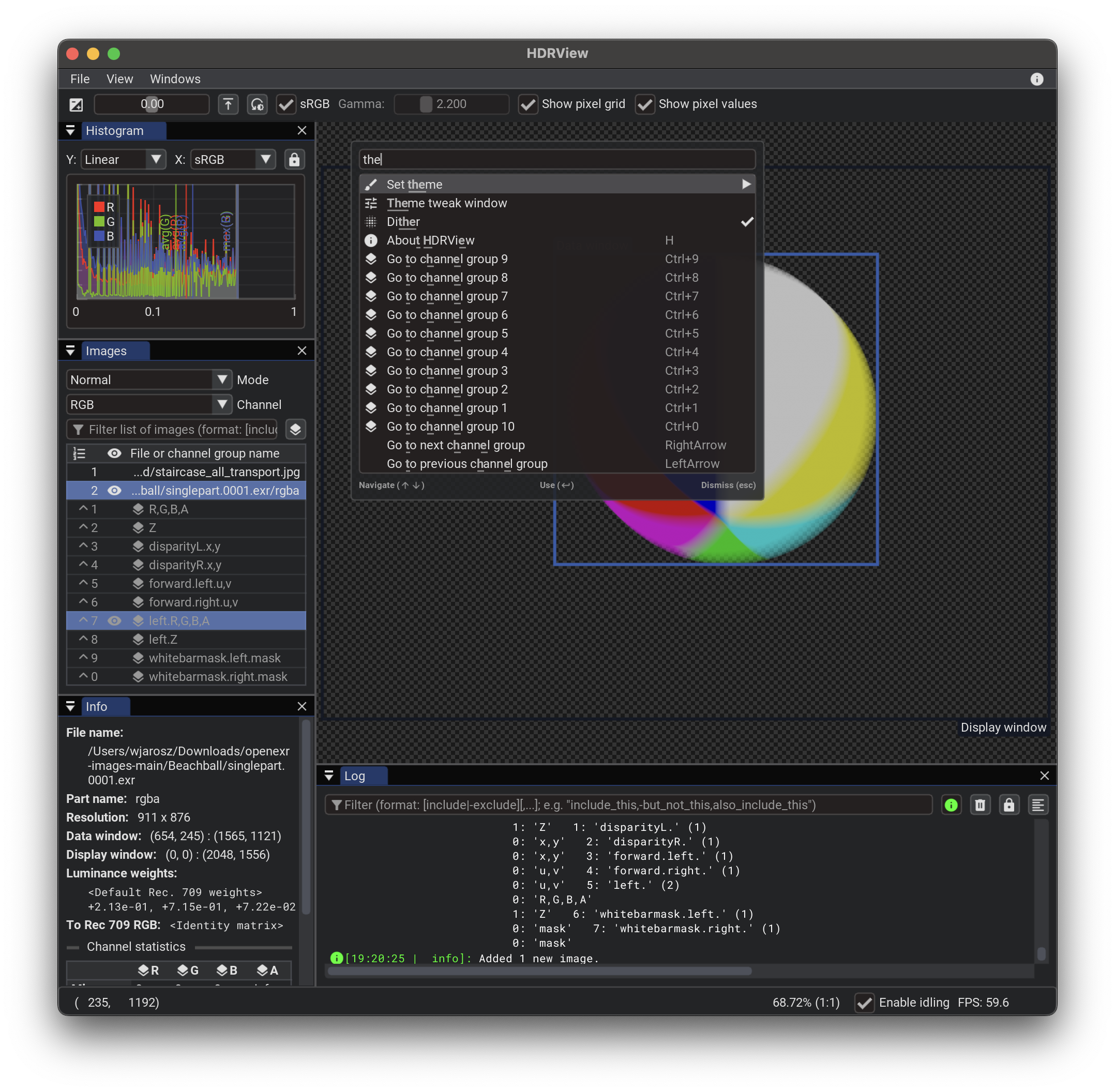HDRView is a simple research-oriented high-dynamic range image viewer with an emphasis on examining and comparing images, and including minimalistic editing and tonemapping capabilities. HDRView currently supports reading EXR, PNG, TGA, BMP, HDR, JPG, GIF, PNM, PFM, and PSD images and writing EXR, HDR, PNG, TGA, PPM, PFM, and BMP images.
HDRView can display true HDR on Apple extended dynamic range (EDR) and 10-bit displays.
HDRView supports loading several images and provides exposure and gamma/sRGB tone mapping control with high-quality dithering of HDR images.

When sufficiently zoomed in, HDRView can overlay the pixel grid and numeric color values on each pixel to facilitate inspection:

In addition to the menubar, HDRView features extensive keyboard shortcuts, and pressing Cmd+Shift+P brings up a VS Code/Atom/Sublime Text-style command palette allowing you to find any command with keyboard-based fuzzy searching:

HDRView supports the extended dynamic range (XDR, 30 bit) capabilities of recent Macs, allowing it to use finer precision (reducing banding) and brighter whites (reducing clipping) when displaying HDR images.
When displaying images on a standard dynamic range (SDR, 24 bit) display (or saving to an LDR file format), HDRView uses high-quality dithering:

This reduces apparent banding artifacts in smooth gradients compared to naively displaying HDR images such displays:

If you are running a recent version of macOS or Windows, you can download the pre-built binary installer DMG or zip file from the releases page. For Linux, you will need to build HDRView from source for now.
Compiling from scratch requires CMake and a recent version of the XCode build tools on macOS, Visual Studio 2015 on Windows, and GCC on Linux.
On Linux and macOS, compiling should be as simple as
git clone --recursive https://github.com/wkjarosz/hdrview.git
cd hdrview
mkdir build
cd build
cmake ../
make -j 4
On Windows, you can run:
git clone --recursive https://bitbucket.org/wkjarosz/hdrview.git
cd hdrview
mkdir build
cd build
cmake ../
-G"Visual Studio 15 2017 Win64"
You can also do this through cmake-gui if you prefer. Run Configure and select your version of Visual C++ and 64bit. Then click Generate.
Open the generated file HDRView.sln and proceed building as usual from within Visual Studio.
This should be as easy as make install. On macOS this will copy the application bundle into /Applications and create the symlink hdrview in /usr/local/bin so you can launch HDRView from the terminal.
Run ./hdrview --help to see the command-line options, or run ./hdrview and hit the h button to see a list of keyboard shortcuts in the application.
There is also a separate executable hdrbatch intended for batch processing/converting images. Run ./hdrbatch --help to see the command-line options.
Copyright (c) Wojciech Jarosz
3-clause BSD. For details, see the LICENSE.txt file.
HDRView depends on the following libraries:
- Wenzel Jakob's NanoGUI library, which is licensed under a BSD-style license.
- ILM's OpenEXR library, which is licensed under a modified BSD license.
- Some stb libraries, developed by Sean Barrett and released into the public domain.
- The tinydir library, which is licensed under a simplified BSD.
- The cli11 library, which is licensed under a 3-Clause BSD license.
- Gabi Melman's spdlog library, which is licensed under the MIT license.
- syoyo's tinydngloader library, which is licensed under the MIT license.